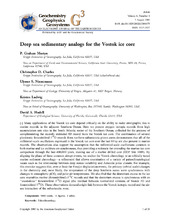| dc.contributor.author | Mortyn, P. Graham | eng |
| dc.contributor.author | Charles, Christopher D. | eng |
| dc.contributor.author | Ninnemann, Ulysses Silas | eng |
| dc.contributor.author | Ludwig, Kristen | eng |
| dc.contributor.author | Hodell, David A. | eng |
| dc.date.accessioned | 2004-07-30T07:55:31Z | en |
| dc.date.accessioned | 2004-08-03T12:57:57Z | en |
| dc.date.accessioned | 2004-08-26T11:58:32Z | |
| dc.date.available | 2004-07-30T07:55:31Z | en |
| dc.date.available | 2004-08-03T12:57:57Z | en |
| dc.date.available | 2004-08-26T11:58:32Z | |
| dc.date.issued | 2003-08-07 | eng |
| dc.Published | Geochemistry, geophysics, geosystems 2003 4(8): 8405 | en |
| dc.identifier.issn | 1525-2027 | en_US |
| dc.identifier.uri | https://hdl.handle.net/1956/407 | |
| dc.description.abstract | Many applications of the Vostok ice core depend critically on the ability to make stratigraphic ties to marine records in the adjacent Southern Ocean. Here we present oxygen isotopic records from high accumulation rate sites in the South Atlantic sector of the Southern Ocean, collected for the purpose of complementing the recently extended ∂D record from the Vostok ice core. The combination of several planktonic foraminiferal ∂18O records from northern subantarctic piston cores demonstrates that all of the millennial-scale oscillations expressed in the Vostok ice core over the last 60 ky are also present in marine records. The observations also support the assumption that the millennial-scale oscillations common to both marine and ice archives are synchronous, thus providing a rationale for extending the marine-ice core comparison through the last 400,000 years, making use of a marine drilled core (ODP Site 1089). By aligning the phase of these common abrupt events, we anchor the Vostok chronology to an orbitally tuned marine sediment chronology—a refinement that allows examination of a variety of paleoclimatological issues such as the relationship between deep ocean variability and Antarctic polar climate. For example, this exercise suggests that, over at least the 4 major deglaciation events, the primary (orbital scale) changes in the chemistry and, most likely, the temperature of the deep Southern ocean were synchronous with changes in atmospheric pCO2 and polar air temperatures. We also find that the deuterium excess in the ice core resembles marine (foraminiferal) ∂13C records and that the deuterium excess is synchronous with an ‘‘anomalous’’ foraminiferal ∂18O signal (the residual between normalized versions of Vostok ∂D and foraminiferal ∂18O). These observations demand a tight link between the Vostok isotopic record and the airsea interaction of the subantarctic zone. | en_US |
| dc.format.extent | 65885 bytes | eng |
| dc.format.extent | 777931 bytes | eng |
| dc.format.extent | 166 bytes | eng |
| dc.format.mimetype | text/plain | eng |
| dc.format.mimetype | application/pdf | eng |
| dc.format.mimetype | text/plain | eng |
| dc.language.iso | eng | eng |
| dc.publisher | American Geophysical Union and the Geochemical Society | en_US |
| dc.subject | Paleoclimatology | eng |
| dc.title | Deep sea sedimentary analogs for the Vostok ice core | en_US |
| dc.type | Peer reviewed | |
| dc.type | Journal article | |
| dc.rights.holder | Copyright the American Geophysical Union | en_US |
| dc.identifier.doi | https://doi.org/10.1029/2002gc000475 | |
